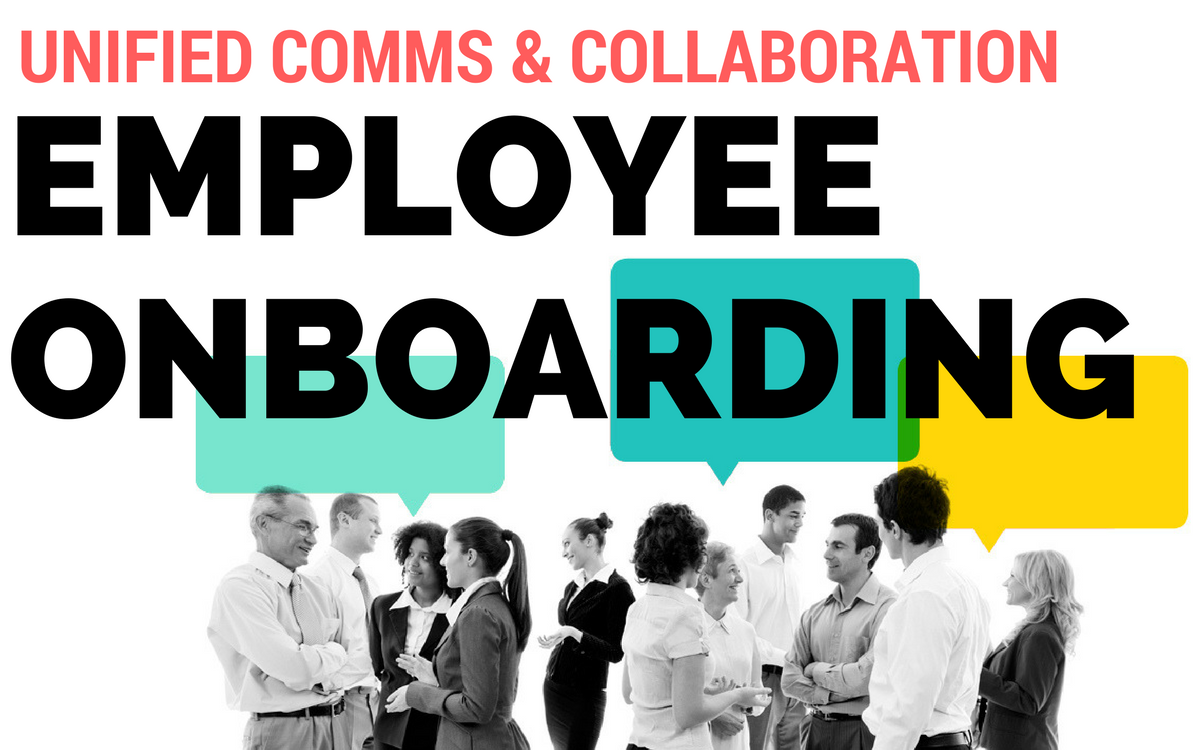I’ve seen it time and again through many company onboarding experiences. Time is spent on many important things: company history, what is expected of new hires, where each department is located, where resources can be found, and so much more. But I still see a huge lack of technology review in most company onboarding programs which is an issue since it’s technology that enables staff to connect and ask questions. These days the types of technologies each business uses and the way they use them vary greatly. No two companies are the same. Which means that for many employees joining a new company, they’re going from one set of company tools to something often completely different.
Learning new tools, especially when being familiar with something different, can be quite intimidating, and not everyone is a tech expert. This is why is is extremely important to spend ample time reviewing company technology during onboarding with a heavy focus on unified collaboration. By having a heavy emphasis on getting your new hires connected to the rest of the organization they can begin to communicate and collaborate more quickly which means shorter ramp time overall.
There’s no better way to help someone succeed quickly at a company than to get them connected, communicating, and collaborating – fast. To do this, you’ll want to focus on making sure they have the collaboration tools they need in the palm of their hand.
Employee Onboarding: The Wrong Way
Remember the “old days” of starting a new job at a new company? If you’ve been in the workforce for 10 years or less, you may not. To make sure we’re all on the same page, let’s all take a trip in the way-back machine: Looking for a new job, you’ve been searching and interviewing for a few weeks or months, finally land the role you’ve been targeting, and head into work on your first day; excited and perhaps a little nervous. You arrive at the office. First, you visit the front desk for direction, head to security to get checked in and receive a badge, or maybe your manager instructed you to meet at their office so they can show you around a bit. Later, you’re directed to your desk area. In it you find your company issued computer or other devices needed for your role, along with some nice notes or cards from your peers and coworkers welcoming you to the team. Somewhere there on your desk is a big packet or binder, thick with what looks like hundreds of printed out pages. This is your employee handbook and onboarding guide.
Your manager tells you to go through the guide so you can get up to speed on particular company info, fill out some important new-hire paperwork, and learn where to find specific resources to help in your job. You’re told not to hesitate to ask any questions that may come up before your manager leaves you to get settled into things. You take a look at the first few sections of the guide before getting distracted by a coworker dropping by to say hello or some other first day of work distraction. You may look at the binder a few more times here and there, but you never make it all the way through. Eventually, the binder finds its way to a drawer, rarely to be seen again.
The first few weeks and months of your new job are filled with moments of uncertainty and questions regarding particular company processes and how to carry out specific tasks you need to complete to get your job done. This is especially true when it comes to getting up to speed on technology the company uses for internal tasks and communication. You ask your manager a few questions here or there but don’t want to bother them too much as they are so busy. The same for your co-workers. Eventually, you get up to speed on specifics on company vision, technology the business uses, and details about how you and your role fit into things, but it is a long process for you, your superiors, and team members. Couldn’t this be better? Thankfully it already is, and it is getting better all the time.
The Benefits of Proper Employee Onboarding (and What Your Missing)
The corporate employee onboarding process has evolved a lot over the past ten years or so, allowing a better first-time experience for new hires while offering many benefits for the employer. Orientation begins before a new hire steps into the office for the first day of work via info via email or access to digital resources and videos. In larger companies, there will usually be a day or two of orientation before starting in on your work. The paper binder has moved to the digital realm, searchable and accessible from your computer, and now your mobile device. Lots of time is saved in providing info on company culture and processes. New hires given ample time to ask questions and be open about any concerns which saves a lot of time for everyone down the road.
Along with a smoother introduction process for a new employee, there are many benefits related to finance and efficiency that come with a proper onboarding practice. I won’t go into detail here as the benefits have been covered many times over in blogs posts and articles on LinkedIn, but major benefits for an employer include big cost savings via reduced turnover, increased efficiency (employees empowered with more info about the business and their role are more likely to “hit the ground running,”) and less distraction for managers and team members because less tasks need to be reviewed and less questions need to be answered.
The benefits on both sides are clear. Modern onboarding programs do a great job of helping a new employee understand company vision and goals as well as how their role fits into the bigger picture. They make new hires feel welcome, build excitement for the work ahead, and aid in getting everyone on the same page so everyone is more efficient when they begin work. They also provide ample benefits to the employer.
Yet there’s still one area that is commonly lacking in most onboarding programs: the collaboration technology the business uses and how employees are expected to communicate and leverage these new unified technologies in order to productive and successful.
Onboarding Necessity: Unified Communications and Collaboration Technology Training
Unified communication and collaboration technologies are becoming a bigger part of the workplace every day. Now, more than ever, it’s crucial that it have an important place in any onboarding program.
A good program will include a review of the most common types of tools the business uses and why the company chose those tools. In gaining an understanding of why a company chose a particular technology, employees will be more inclined to use them. This is especially true when it comes to company collaboration tools which can be the most intimidating of all. Setting up and running video meetings has become common practice for many businesses and often feels like extra work for employees on top of running an actual meeting. Providing resources and instruction to make new hires feel more comfortable in the collaboration process goes a long way in easing the stress of this part of the job.
Once the reasoning behind why particular tools are used it is a great idea to have some demo sessions during onboarding where employees can see the tools in action. Whether you are going over how to open a ticket or how to book and start up a video conferencing call, a small amount of time here will save many hours down the road. Lastly, if your business has internal training resources it should be clearly explained how to access them so employees can get more information or take trainings after onboarding has ended.
8 Essentials for a Successful Employee Onboarding Program
Now that we’ve reviewed the benefits that onboarding programs provide as well as mentioned one area that could be improved, let’s take a look at what an impactful onboarding process might include.
- Start Before the First Day: It is common for new hires’ email accounts (and these days Slack accounts) to be set up in advance of their start date. Through these channels, it is a great idea to provide some basic info and what to expect for orientation. Basic agendas and overviews are helpful in building excitement and getting the wheels turning.
- Make it Immersive: Best practice for onboarding is an immersive, multi-day (but not too many days; two is generally best) experience in which the sole purpose is getting up to speed on all the things. No distractions of work tasks until onboarding is over.
- Manager Check-in Lunch: This is a small detail that is extremely beneficial. Time for lunch with a manager should be set aside to give to check in and see how things are going. If a new hire might not have wanted to ask a particular question in a group onboarding session maybe they would be more comfortable asking their manager directly. It is a great opportunity to encourage open feedback.
- Encourage Openness: While we have come a long way, many companies could do better and creating and inviting and open culture. Employees should be encouraged and feel comfortable in providing feedback (complementary and constructive) to their peers and especially their managers. We all get better through honest and open feedback and this should be discussed in onboarding.
- Company History and Culture: A core feature of onboarding. How did the company get its start? What has its journey been to date? What are its values and current goals? What do things look like five years from now?How can new employees help reach company goals?
- Include an Executive: This is another item that can go a long way in onboarding. When a company executive spends a little time with new hires during onboarding it helps make people feel included and important. Even if it is a quick 30 minutes in the room or over a video call discussing how they got their start with the company or what is important to them, it means a lot for new employees.
- COLLABORATION TECHNOLOGY: As covered previously, technologies specific to the way the company works should be explained even demoed. It should be discussed why particular technologies were chosen and how it will help the company if they employee embraces and uses the chosen technologies. Resources should be provided so employees can follow up if needed.
- Make it Fun: Onboarding should be informative but also fun. Along with providing essential information, time should be taken for new hires to get to know each other in onboarding. Fun games can be played such as a scavenger hunt where new hires have to find bits of information via the company intranet or throughout the building. Buddy programs can be helpful, teaming up a new employee with a seasoned one and taking care of a few new tasks together. Another great idea that has been around for a while is that the newest member of a team is responsible for making the newest team member welcome, creating a custom onboarding packet and helping in getting up to speed. Lastly, we can’t forget day one fun of adding some fun stuff to a new team member’s desk or finding a clever way of introducing them to the team or company outside of the standard email announcement.
Thanks for reading! If you have questions or thoughts please feel free to post them in the comments section below. We would love to hear about your experience..









